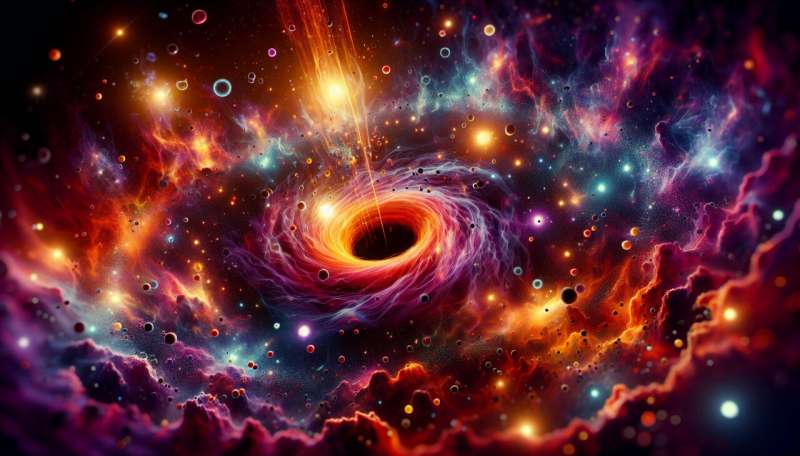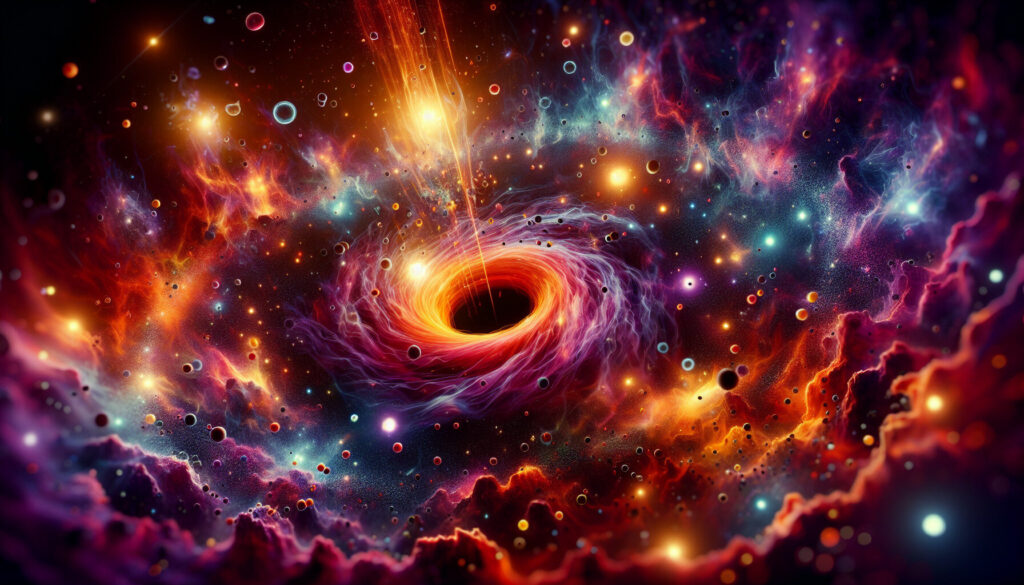
Credit: Image generated by AI
For every kilogram of matter we can see—from the computer on your desk to the stars and distant galaxies—there are 5 kilograms of invisible matter filling our environment. This “dark matter” is a mysterious entity that eludes all forms of direct observation, but makes its presence felt through its invisible pull on visible objects.
Fifty years ago, physicist Stephen Hawking offered an idea of what dark matter might be: a population of black holes that could have formed very soon after the Big Bang.
Such “primordial” black holes would not have been the goliaths we detect today, but microscopic regions of ultradense matter that would have formed in the first quintillionth of a second after the Big Bang and then collapsed and dispersed through the cosmos, pulling away. that surround spacetime in ways that may explain the dark matter we know today.
Now, MIT physicists have found that this primordial process would also have produced some unexpected companions: even smaller black holes with unprecedented amounts of a property of nuclear physics known as “color charge.”
These smaller, “supercharged” black holes would have been an entirely new state of matter, likely vaporizing a fraction of a second after they were created. However, they could still have affected a key cosmological transition: the time when the first atomic nuclei were forged.
Physicists postulate that color-charged black holes may have affected the equilibrium of the fused nuclei, in a way that astronomers may one day discover with future measurements. Such an observation would convincingly point to primordial black holes as the root of all dark matter today.
“Although these short-lived exotic creatures are not around today, they may have influenced cosmic history in ways that can show up in subtle signals today,” says David Kaiser, Germeshausen Professor of the History of Science and professor of physics at MIT. “Within the idea that all dark matter can be accounted for by black holes, it gives us new things to look for.”
Kaiser and his co-author, MIT graduate student Elba Alonso-Monsalve, have published their study in the journal Physical review papers.
A time before the stars
The black holes we know and detect today are the product of stellar collapse, when the center of a massive star collapses in on itself to form a region so dense that it can bend space-time so that everything, even light, gets stuck inside. . Such “astrophysical” black holes can be anywhere from a few times the size of the sun to billions of times larger.
“Primordial” black holes, in contrast, can be much smaller and are thought to have formed at a time before the stars. Before the universe had prepared the basic elements, let alone stars, scientists believe that pockets of ultra-dense, primordial matter could have accumulated and collapsed to form microscopic black holes that could be dense enough to squeeze the mass of an asteroid in a region as small as a single atom. The gravitational pull of these tiny, invisible objects scattered throughout the universe could explain all the dark matter we can’t see today.
If so, then what would these primordial black holes have been made of? That’s the question Kaiser and Alonso-Monsalve tackled with their new study.
“People have studied what the mass distribution of black holes would have been like during this early production of the universe, but they never related it to what kind of stuff would have fallen into those black holes at the time they were forming. formed,” explains Kaiser.
Supercharged Rhinos
The MIT physicists first looked through existing theories about the possible distribution of black hole masses as they were first forming in the early universe.
“Our realization was that there is a direct relationship between when a primordial black hole forms and at what mass it forms,” says Alonso-Monsalve. “And this time window is absurdly early.”
She and Kaiser calculated that primordial black holes must have formed within the first quintillionth of a second after the Big Bang. This burst of time would have produced “typical” microscopic black holes that were as massive as an asteroid and as small as an atom. It would also have produced a handful of exponentially smaller black holes, with the mass of a rhinoceros and a size much smaller than a single proton.
What would these primitive black holes have been made of? For this, they looked to studies exploring the composition of the early universe, and in particular, the theory of quantum chromodynamics (QCD) – the study of how quarks and gluons interact.
Quarks and gluons are the basic building blocks of protons and neutrons—the elementary particles that combined to create the basic elements of the periodic table. Immediately after the Big Bang, physicists estimate, based on QCD, that the universe was an extremely hot plasma of quarks and gluons that then quickly cooled and combined to produce protons and neutrons.
The researchers found that, within the first quintillionth of a second, the universe would still have been a soup of loose quarks and gluons that had yet to combine. Any black holes that formed at this time would have swallowed unbound particles, along with an exotic property known as “color charge”—a state of charge carried only by uncombined quarks and gluons.
“Once we realized that these black holes form in a quark-gluon plasma, the most important thing we had to figure out was, how much color charge does the blob of matter contain that will end up in a primordial black hole?” says Alonso-Monsalve.
Using QCD theory, they worked out the color charge distribution that should exist throughout the hot, early plasma. Then they compared it to the size of a region that will collapse to form a black hole in the first quintillionth of a second. It turns out that there wouldn’t be much color charge in most typical black holes at the time, since they would have formed by absorbing a large number of regions that had a mixture of charges, which would have eventually added up to a “neutral”. ” Loading.
But smaller black holes would be loaded with color. In fact, they would have contained the maximum amount of any kind of charge allowed for a black hole, according to the basic laws of physics. While such “extreme” black holes have been hypothesized for decades, until now no one had discovered a realistic process by which such wonders could actually have formed in our universe.
Supercharged black holes would have evaporated quickly, but perhaps only after the time when the first atomic nuclei began to form. Scientists estimate that this process began about a second after the Big Bang, which would have given the supermassive black holes enough time to disrupt the equilibrium conditions that would have prevailed when the first nuclei began to form. Such perturbations could potentially affect how those earliest nuclei formed, in ways that may one day be observed.
“These objects may have left some exciting observational traces,” Alonso-Monsalve thinks. “They could have changed the balance of this versus that, and that’s the kind of thing you start to wonder about.”
More information:
Elba Alonso-Monsalve et al, Primordial Black Holes with QCD Color Charge, Physical review papers (2024). DOI: 10.1103/PhysRevLett.132.231402. journals.aps.org/prl/abstract/ … ysRevLett.132.231402
Provided by the Massachusetts Institute of Technology
This story is reprinted courtesy of MIT News (web.mit.edu/newsoffice/), a popular site covering news about research, innovation, and teaching at MIT.
citation: Exotic black holes may be a byproduct of dark matter (2024, June 6) Retrieved June 6, 2024 from https://phys.org/news/2024-06-exotic-black-holes-byproduct-dark. html
This document is subject to copyright. Except for any fair agreement for study or private research purposes, no part may be reproduced without written permission. The content is provided for informational purposes only.

